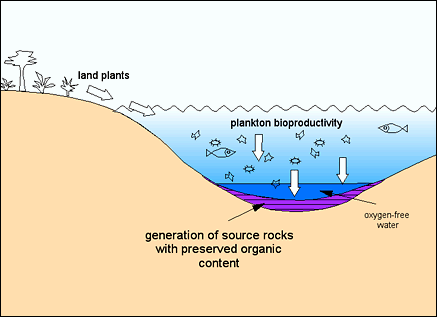|
Petroleum comes from the remains of microscopic plants and animals called zooplankton and phytoplankton. These plants and animals floated on bodies of water millions of years ago. When these living organisms died, they sunk to the bottom of the water and mixed with bottom materials, such as mud, sand, and silt. During the next several thousand years these decaying organisms got buried deeper and deeper underneath the floor of the body of water (National). These layers, because they did not contain much oxygen (oxygen is needed to decompose organic material), piled up helping to preserve the organisms (RWE Dea). As the layers built up, the temperature and pressures increased drastically and converted the organisms into compounds of hydrogen and carbon, hydrocarbons, which are the basis for petroleum. The oil producing algae include coccoliths, dinoflagellates, and diatoms (Instructional). In the end, an oil saturated rock is formed, looking much like a sponge (Colorado University). The oil naturally flows towards the center of the earth, but along the way much of it gets stuck in pores and subterranean rocks. The rock oil may be brought to the surface by drilling wells into underground reservoirs (National). This is the source of the oil, which allows those nice looking Lamborghini Diablos to accelerate from zero to sixty miles per hour in less than three seconds.

|
| http://www.rwedea.com/en/160_39213.htm |
|




